Hybrid cars CAN be identified very easily in the auctions, without a thorough knowledge of the make or model. The key to identifying a hybrid from a normal model, is the way cars are presented on the auction sheets in the auctions. The emissions code.
The emissions code, the secret code to success!
Success being: finding out whether the car is a hybrid or not anyway! Each auction sheet will list the emission code before the chassis type. This same code can be found on the registration/dereg. document. There are 3 letters you need to remember: A C L . Pronounced in Japanese: aye shi eru. There is also a number you need to remember: 2.
All modern cars have a 3 digit emissions code (double digit emission codes exist but that was before hybrids came into use). So here is the key:
If the 2nd letter of the emissions code is A C or L, the car is either electric or hybrid.
Also, if you are after a hybrid and NOT an electric, go to the emissions code. If the car is electric, the FIRST letter will be Z.
Examples of emission codes taken from auction sheets
Probably the best way to learn this method is by grabbing some examples from the auctions. Your honor, let me present the first piece of evidence:
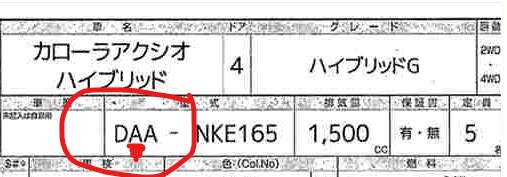
Without reading the model type, the 2nd letter is an “A”, so the car is either hybrid or electric. It is a Corolla Axio, so it is hybrid.
Your honor, item 2:
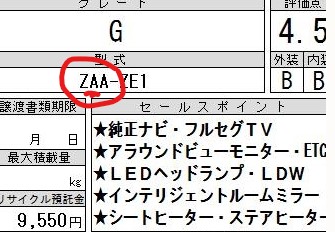
The 2nd letter again is an “A”, the car must be hybrid or electric. In this case the FIRST letter is a “Z” so it MUST be electric. This car is a Nissan Leaf.
Your honor, item 3:

The 2nd letter is a “B”, which is NOT “A C or L” so the car is neither hybrid nor electric.
I said before the emissions code is also written on the export document, let’s have a look at one of those and where that emission code is.
Your honor, item 4:
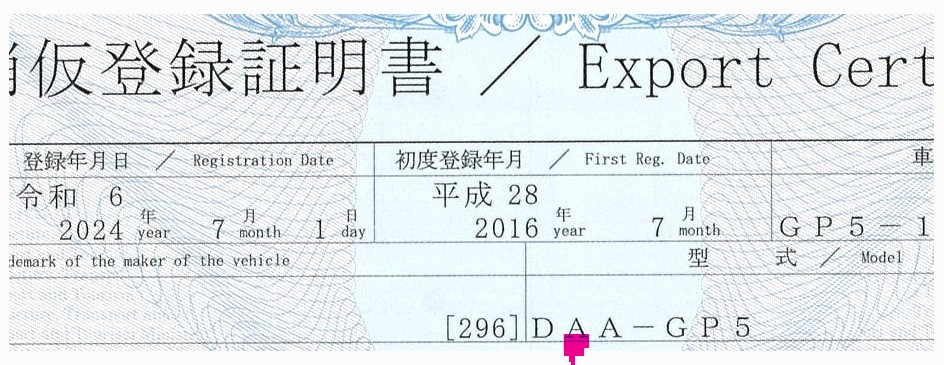
2nd letter: A, first letter is NOT Z: the car is a hybrid.
What is a hybrid car?
A hybrid car uses both a gasoline engine and an electric motor. It has a small battery that powers the electric motor, but it doesn’t need to be plugged in. Instead, it uses regenerative braking to capture energy when slowing down, storing it in the battery for later use. This process improves fuel efficiency, especially in city driving. Hybrids have smaller batteries compared to full electric vehicles and blend traditional brakes with regenerative braking for optimal performance.
Is a list of hybrid cars the answer?

In the Japanese auctions many models are sold as both hybrid versions and non-hybrid versions. So is it worthwhile making a list of what IS hybrid and what ISN’T hybrid? As soon as the list is made, the maker turns out another model and the list becomes out of date! So by far the easiest method of recognizing a car being hybrid is by its emission code. Here at Providecars a Mercedes Benz was bought in the auctions and the sales staff involved as well as the most car knowledgeable Japanese staff firmly stated the car was NOT hybrid. One of the other staff who knew the above rule but knew nothing about car models, looked at the emissions code and stated it was hybrid. A call to the auction confirmed the car was a hybrid. So the only tool needed to recognize a hybrid car in the auctions is the emissions code!
Japan NOT sprinting down the EV road
Toyota, the biggest car maker in the world, is not the leader when it comes to EVs. Their plans are to deliver 1.5 million EVs by 2026, 14% of their total projected sales. This is hardly huge. The Japanese makers do not see EVs as the future but rather fuel efficient hybrid vehicles. Toyota still is investing more into hybrids and “other” fueled vehicles rather than electrics. If you are purchasing a vehicle from Japan, the likelihood of it becoming a hybrid in the near future is large. Also the likelihood of it becoming a hydrogen cell fueled vehicle is very small, especially in the next 10 years, as there is no infrastructure (even in Japan) to back the move.
Toyota Prius the trail blazer
In the 1970’s when USA was churning out gas-guzzling “big” cars the oil crunch hit. Japan or Toyota specifically, looking for a more gas efficient car, bought the technology from an American engineer named Alex Severinsky. He had developed the “Hyperdrive” power-amplified internal combustion engine power train, which is a crucial component of the hybrid system used in the Prius.

Severinsky patented his invention in 1994, and Toyota licensed this technology, which became a fundamental part of the Prius’s hybrid system. His work laid the groundwork for the development and commercialization of hybrid vehicles, combining an internal combustion engine with an electric motor to improve fuel efficiency and reduce emissions.
Toyota used the hybrid technology to create the first Prius, which was introduced to the market in Japan in December 1997. This marked the world’s first mass-produced hybrid car. The Prius combined an internal combustion engine with an electric motor, utilizing the hybrid technology that Alex Severinsky’s invention had helped to pioneer. The success of the Prius played a significant role in popularizing hybrid vehicles globally.
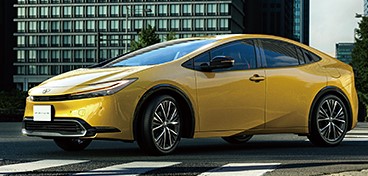
As of 2024, the latest generation of the Toyota Prius available in the Japanese market is the fifth generation. This generation was introduced in late 2022 and continues to build on the Prius’s legacy of hybrid technology with improvements in design, efficiency, and performance. Although this year, 2024, the production line was closed down due to a very large world-wide recall (possibility of doors opening on their own in the rain!).
Now, let’s come back a full circle and do the above emissions test on this 5th generation Toyota Prius. Chassis type: MXWH65. Here is a slice of an auction sheet here:
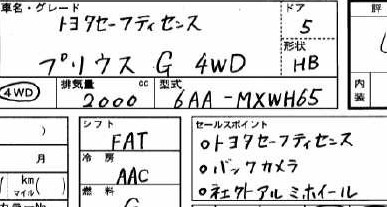
Can you see for yourself whether this hybrid obeys the “A C L” emission rules? Let’s update the above shot with a little bit of red to help:
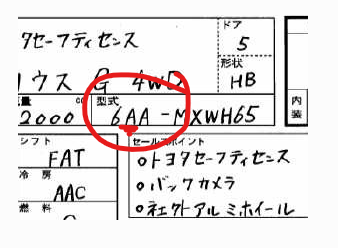
2nd letter IS “A C or L” and the first letter is NOT a “Z” so the car IS hybrid and the car is NOT electric.
So even the lastest models keep the emissions hybrid laws!
What about non-Japanese models, hybrids?
So does this “A C or L” rule cover the foreign import models in Japan that are hybrid vehicles? Let’s check a few.
First up, VW Passat, no “mention” at all on the auction sheet that the car is a hybrid, but let’s check the emissions:
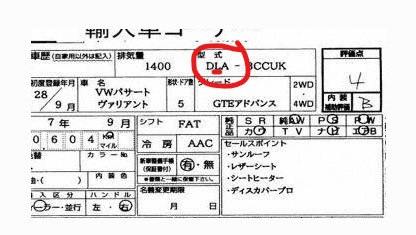
2nd letter is L which comes under the “A C L” rules, it is a hybrid.
Next up, a 2016 VW Golf GTE
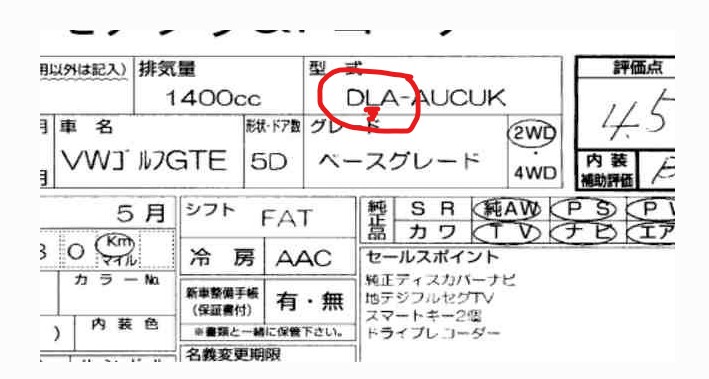
Same again, 2nd letter is L which comes under the “A C L” rules, it is a hybrid. No mention on the auction sheet this car is a hybrid.
Lastly, just to show that it is not only VW, but also BMW:
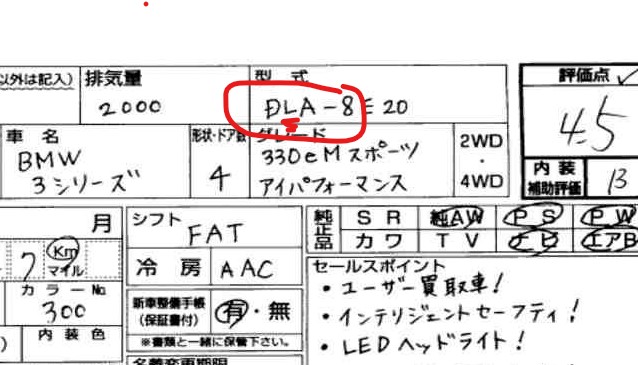
BMW 3 series e Sports. Again, there is no mention on the auction sheet that this car is a hybrid. If you know all your BMW models and which ones are hybrid, great. If you don’t you can immediately recognize by this emissions code test.
Why does it matter?
When we export by container, any vehicle that is hybrid is classified as “dangerous goods” and has to go through a specific application to the shipping line. Added to this the shipping line will charge us around $1500 US EXTRA per container (this does not happen for RORO shipping). Not knowing a vehicle is hybrid when exporting could have serious financial consequences!
Also, a car being hybrid SHOULD be a positive result for the importer. It should add more value. So when bidding in the auctions, and you can QUICKLY recognize the vehicle is a hybrid, you may want to add more to your bid price.
At Providecars we seek every detail so our customers can have an edge over other dealer’s customers. Why not join us and receive those edeges yourself?